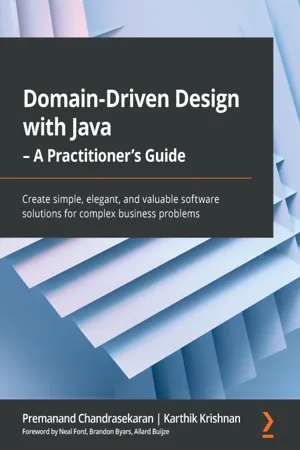
Domain-Driven Design with Java - A Practitioner's Guide
- 302 pages
- English
- ePUB (mobile friendly)
- Available on iOS & Android
Domain-Driven Design with Java - A Practitioner's Guide
About this book
Adopt a practical and modern approach to architecting and implementing DDD-inspired solutions to transform abstract business ideas into working software across the entire spectrum of the software development life cycleKey Features• Implement DDD principles to build simple, effective, and well-factored solutions• Use lightweight modeling techniques to arrive at a common collective understanding of the problem domain• Decompose monolithic applications into loosely coupled, distributed components using modern design patternsBook DescriptionDomain-Driven Design (DDD) makes available a set of techniques and patterns that enable domain experts, architects, and developers to work together to decompose complex business problems into a set of well-factored, collaborating, and loosely coupled subsystems.This practical guide will help you as a developer and architect to put your knowledge to work in order to create elegant software designs that are enjoyable to work with and easy to reason about. You'll begin with an introduction to the concepts of domain-driven design and discover various ways to apply them in real-world scenarios. You'll also appreciate how DDD is extremely relevant when creating cloud native solutions that employ modern techniques such as event-driven microservices and fine-grained architectures. As you advance through the chapters, you'll get acquainted with core DDD's strategic design concepts such as the ubiquitous language, context maps, bounded contexts, and tactical design elements like aggregates and domain models and events. You'll understand how to apply modern, lightweight modeling techniques such as business value canvas, Wardley mapping, domain storytelling, and event storming, while also learning how to test-drive the system to create solutions that exhibit high degrees of internal quality.By the end of this software design book, you'll be able to architect, design, and implement robust, resilient, and performant distributed software solutions.What you will learn• Discover how to develop a shared understanding of the problem domain• Establish a clear demarcation between core and peripheral systems• Identify how to evolve and decompose complex systems into well-factored components• Apply elaboration techniques like domain storytelling and event storming• Implement EDA, CQRS, event sourcing, and much more• Design an ecosystem of cohesive, loosely coupled, and distributed microservices• Test-drive the implementation of an event-driven system in Java• Grasp how non-functional requirements influence bounded context decompositionsWho this book is forThis book is for intermediate Java programmers looking to upgrade their software engineering skills and adopt a collaborative and structured approach to designing complex software systems. Specifically, the book will assist senior developers and hands-on architects to gain a deeper understanding of domain-driven design and implement it in their organization. Familiarity with DDD techniques is not a prerequisite; however, working knowledge of Java is expected.
Frequently asked questions
- Essential is ideal for learners and professionals who enjoy exploring a wide range of subjects. Access the Essential Library with 800,000+ trusted titles and best-sellers across business, personal growth, and the humanities. Includes unlimited reading time and Standard Read Aloud voice.
- Complete: Perfect for advanced learners and researchers needing full, unrestricted access. Unlock 1.4M+ books across hundreds of subjects, including academic and specialized titles. The Complete Plan also includes advanced features like Premium Read Aloud and Research Assistant.
Please note we cannot support devices running on iOS 13 and Android 7 or earlier. Learn more about using the app.
Information
Table of contents
- Domain-Driven Design with Java – A Practitioner’s Guide
- Forewords
- Preface
- Part 1: Foundations
- Chapter 1: The Rationale for Domain-Driven Design
- Chapter 2: Where and How Does DDD Fit?
- Part 2: Real-World DDD
- Chapter 3: Understanding the Domain
- Chapter 4: Domain Analysis and Modeling
- Chapter 5: Implementing Domain Logic
- Chapter 6: Implementing the User Interface – Task-Based
- Chapter 7: Implementing Queries
- Chapter 8: Implementing Long-Running Workflows
- Chapter 9: Integrating with External Systems
- Part 3: Evolution Patterns
- Chapter 10: Beginning the Decomposition Journey
- Chapter 11: Decomposing into Finer-Grained Components
- Chapter 12: Beyond Functional Requirements
- Other Books You May Enjoy